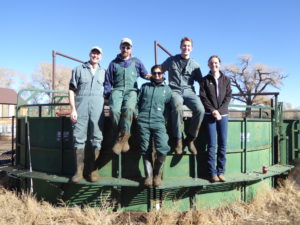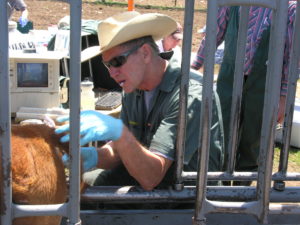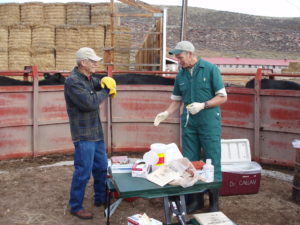Editor’s note: The newly formed Provost’s Council for Engagement is made up of a dozen faculty members representing all eight colleges and Morgan Library. Council members serve as champions for advancing the practice and recognition of engaged scholarship as fully embedded within CSU’s core teaching, research and service missions. Each month we are profiling a different member of the Council, who will in their own words help showcase the diversity of engaged scholarship across campus, as well as the impact of this work on communities and the university. Five council members – Martin Carcasson, Christine Fruhauf, Neil Grigg, Bill Shuster and Robin Reid – have been profiled.
This month we meet Frank Garry, who has been a professor in the Department of Clinical Sciences for 30 years. Since 1996, Garry has been the coordinator of the Integrated Livestock Management program, a multidisciplinary graduate studies program that focuses research and training efforts at problems in cow/calf, feedlot and dairy agriculture.

What, in your opinion, is ‘faculty engagement’?
“Engaged scholarship is work with an outside community, helping them solve problems, while integrating students and research into the process.
My area of expertise is livestock health, and the communities I work with are dairy and beef producers. In the mid 1990s several colleagues and I created the Integrated Livestock Management program here at CSU. The purpose of the program was to focus graduate studies, teaching and research towards problems that affect livestock health and productivity. We listen carefully to producer issues and identify problems important to them where we think that working together we can make a difference. This makes service, teaching and research an inseparable set of activities.
It is very meaningful to me when the livestock producers, the students, and the faculty and staff are all helping one another.”
How have you, your program or students benefitted from what you have learned as an engaged faculty member? And, has there been any sort of reciprocity or two-way learning with the communities outside of CSU that you have been involved with?
“The way our ILM program works is a collaboration between producers, students, faculty and staff, and all participants benefit. This is mostly field-based work, and students must be involved in the livestock production environment. They are obliged to understand the producer’s community and challenges and the animals that the producer is raising. This is the single best learning environment they can have. Interactions between producers and students can be magical. The producers teach and learn from the students, and vice versa.
Virtually all livestock production problems are multi-factorial and multidisciplinary. Therefore, almost all our projects involve multiple faculty and different approaches to the problem. I enjoy seeing the students mature in this process. They develop expertise, confidence and pride in their work at the same time they are learning humility. It takes a team to work on problems like this, and individual expertise can only accomplish a part of the task. In an engagement process, the student sees that our role is to work ‘with’ the producer instead of delivering an answer as an outside ‘expert.’
When the engagement process works well, we have helped the producers and the animals, learned along the way, and empowered young professionals to use their skills and knowledge in other communities and situations in the future.”

Why are you involved with this council, and how does it relate to your work or research?
“I am involved with the council because I believe the university has a special obligation and opportunity to provide value to our society. CSU is a land-grant university with a historical mandate for public education and practical applications of knowledge for the improvement of society. We have many ways to do this, but none are more powerful than engaged scholarship. During engagement we not only develop new information and problem-solving, but do so in the process of educating tomorrow’s thought leaders while positively affecting the communities of today.
While my specialty area is in cattle health and production agriculture, I am surrounded by colleagues throughout the university with a remarkably broad array of expertise, ranging from the arts to science and technology to business, and so on. If this council can help promote and develop pathways for the university to become increasingly engaged with the many communities we serve, it would be a win for all involved.
Whenever I see other faculty, staff or students involved in engagement activities, it appears to enrich their lives and add purpose to their pursuits. In my experience, people thrive when they see that their efforts help others. The more our university increases its engagement with communities, the better it will be, and I believe CSU can become the gold standard for how a public university returns value to society.”
What do you hope the council is able to accomplish?

“I hope the council can increase the visibility of the many engagement activities that are currently being conducted at CSU. Many talented people at CSU are involved in projects and teaching that directly work with communities at the local, state, national and international levels. Recognizing and calling attention to these efforts is a first step.
I would like to see the council develop methods to promote even greater involvement in engagement activities, especially including young faculty. It is common for young faculty to approach the multiple expectations of their appointment separately. Integrating research and teaching together in engaged scholarship is a powerful way to improve the impact of their efforts.
And I would especially like to see outside communities recognize the value that engagement with the university offers. It grieves me when I hear community members refer to ‘ivory tower’ activities, and their perception that university activities are distant from their concerns. Engagement is the vehicle to connect the university with communities outside of academia, and the more we engender university engagement the more integral our university becomes to society.”